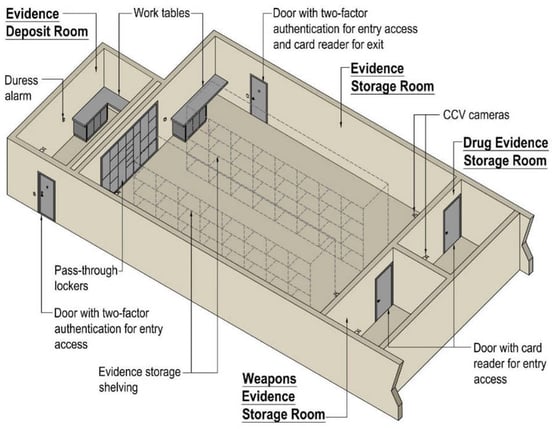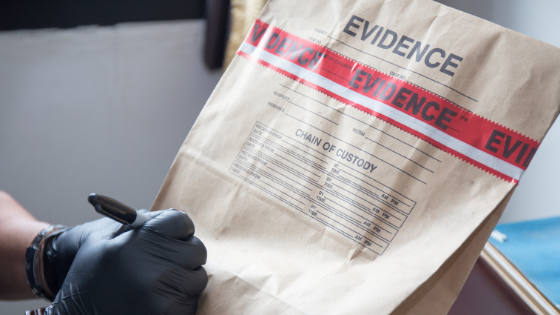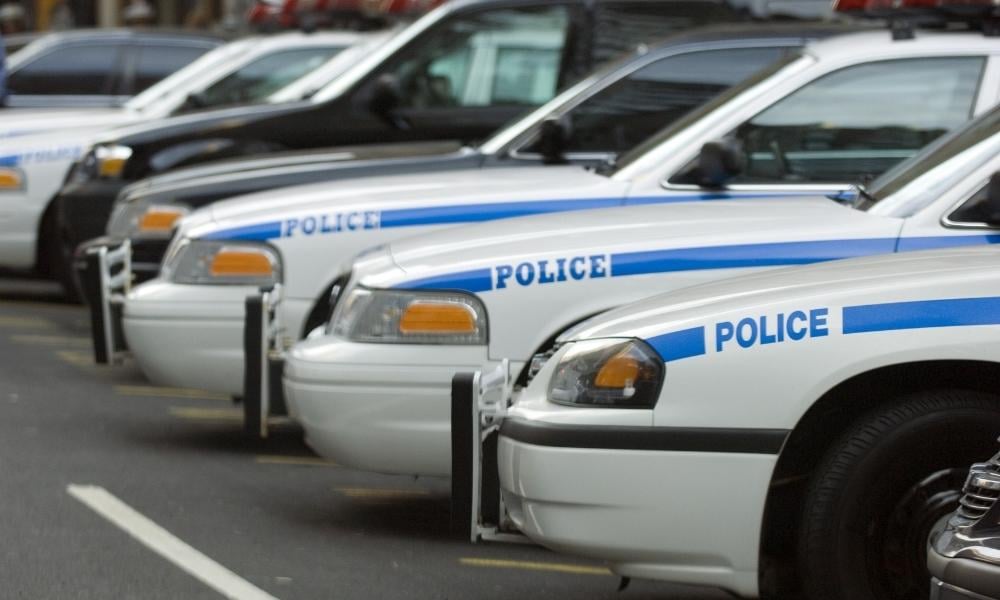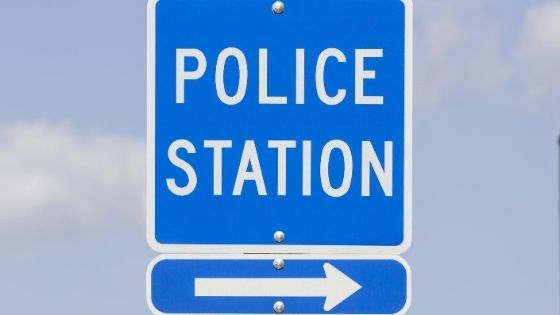Evidence is a key aspect of the criminal justice system, and how that evidence is handled can make or break a case. A secure and well-functioning evidence storage room, also called a property room, is critically important to the prosecution and defense of crimes. Continuing my series on best design practices for police stations, let’s look at some guidelines for the design of an evidence storage area that can help a police department maintain and track evidence appropriately.
Location and Adjacencies
When deciding where the evidence storage room should be located, it’s important to consider the workflow of how pieces of evidence will be logged into the evidence storage room. Officers first drop off evidence in a secure, temporary location (evidence deposit room) that is accessible to officers on a 24/7 basis. After this initial drop-off, the evidence is only accessible to the property officer, who is in charge of operating and maintaining the evidence. The evidence is typically stored by the property officer in an evidence storage room, where the evidence will ultimately be held long term. For this transfer of evidence to take place efficiently and securely, it is ideal for the evidence deposit room and evidence storage room to be located directly adjacent to one another.
A chain of custody must always be maintained for evidence, with clear protocol for the transfer of evidence. A best practice I’ve observed for this transfer is a series of pass-through lockers located between the evidence deposit room and the evidence storage room. Once a police officer has packaged the evidence, placed it in the locker, and securely closed the locker, the locker can only be opened on the evidence storage room side by the property officer. This arrangement satisfies court chain of custody standards.
Both the evidence deposit room and evidence storage room should be secure spaces accessible only to authorized personnel. Officers who enter the building from patrol should be able to access the evidence deposit room via restricted (non-public) circulation. Access to the evidence storage room should be from the criminal investigative parts of the police facility only.
Below is a basic layout for a police facility evidence area. This drawing is meant to be a concept plan only; it is not to scale and does not show all potential requirements.

Evidence Room Concept Plan
Layout, Furnishings, and Fixtures
The officers responsible for bagging and tagging evidence in the deposit room need a place to fill out reports and to label evidence. Work counters should be provided for this purpose, and evidence bags and boxes should also be provided. In the evidence storage room, the property officer should be provided with a work surface or desk near the pass-through lockers.
Evidence comes in all sizes and types. For the pass-through lockers, a variety of locker sizes should be provided for different items such as evidence bags, handgun boxes, and rifles. Refrigerated pass-through lockers should also be available for biological evidence. Secure pass-back lockers could also be provided for a chain-of-custody release of evidence out of the storage room (for example, when evidence needs to be taken to the courtroom).
The evidence storage room should contain rows of shelving to hold evidence boxes, envelopes, and bags of different shapes and sizes. Specialized shelving and lockers should be provided for evidentiary weapons storage and drug storage in secure rooms that are separate from the rest of the evidence storage room, with separate key card access. A safe should be provided for monetary evidence. Also, cold storage units should be provided for biological or other perishable evidence. The cold storage area should be equipped with a system that sends a notification alarm upon any malfunction of the climate-controlled system.
 Evidence Room Storage Shelves
Evidence Room Storage Shelves
Walls
The walls of an evidence storage room should be of sturdy construction to prevent anyone from breaking into the space. The walls should be solid block construction (or blocks with concrete-filled cores) since gypsum board/drywall and stud partitions are too easily kicked through. If gypsum board and studs are used, a security mesh should be added between the gypsum board and studs.
The walls should run from the floor deck below to the underside of the above floor or roof deck to prevent access by climbing over a void between the top of a low wall and the underside of the floor or roof deck above. Even the holes that ducts run through are potential places where unwarranted access could occur. All ducts through the walls should have a security mesh inside to prevent anyone from crawling into the evidence storage room.
Doors and Access Control
Doors need to be flush metal or metal clad with solid cores to prevent breaching, and should be windowless. Objects and information gathered inside the evidence storage room are sensitive and should not be able to be viewed from outside the room. All hinges should be unable to be removed, or should be on the secure side of doors. All doors should have automatic closers. A wide-angle viewer should be provided on the doors to the main evidence storage room and the evidence deposit room to provide a clear view of the area immediately outside each room.
Access to the evidence storage room should be restricted to the property officer and select authorized personnel using two-factor authentication – in this case by using a cipher lock/keypad and a card reader. The card reader system provides a record of who accesses the room and when. The use of a card reader should also be required to exit the evidence storage room, again to maintain an electronic record of the use of the room.
Card readers should also be required to gain access into the separate rooms for firearms storage and drug storage. Access into the evidence deposit room should also be restricted with two-factor authentication, similar to the storage room.
Ceiling
A solid gypsum board ceiling is preferred to help prevent an individual with unauthorized access from crawling up into the ceiling. If a suspended ceiling is used, it should be the type that can have tamper-proof, lock-down tiles, not just to prevent escapes, but also to prevent anyone from hiding contraband items above the ceiling. Whether a gypsum board or suspended ceiling is used, security mesh should be installed above the ceiling to provide greater protection against ceiling breaches.
As is the case with the walls, any ductwork in the ceiling should be protected with security mesh inside the ductwork.
Floors
Because of the nature of evidence, there is a potential for hazardous materials to be stored in the room. Therefore, a floor with a durable finish that is easy to clean is required. Vinyl tile is durable, but hazardous material could accumulate in the seams between tiles. A preferred flooring is a seamless poured epoxy on concrete, including a continuous epoxy cove base. There should be no sharp corners or seams between the base and the floor where spilled material could get trapped. A floor drain should not be provided, as it could allow hazardous materials to enter the drainage system.
Electronic Security
There should be full closed-circuit video (CCV) coverage of every part of the evidence storage room and evidence deposit room, with no blind spots or obstructions. This would likely require multiple cameras and possibly 360-degree cameras. Additionally, each door should be on door position switches that report back to the central control center. An alert should automatically sound and report to the central control post when doors are held open too long or do not latch properly.
The evidence storage room should be equipped with duress alarms in key locations for use in case of emergency, such as a hazardous material spill. Motion detectors should also be provided for after-hour intrusion monitoring.
HVAC and Air Quality
Even evidence that does not require refrigeration can degrade over time, especially in high heat environments. It is recommended that the air temperature be maintained at no higher than 75 degrees and with relative humidity that does not exceed 60%.
The drug storage room should have its own ventilation system that exhausts to the outside of the building. This prevents dangerous materials from recirculating back into the HVAC system for the rest of the police facility. Also, the HVAC system in the drug storage room should change the air 10 to 12 times per hour, and should be a negative-pressure system.
Ensuring Enough Storage Space for the Future
An electronic evidence management system is a must for the efficient operation of an evidence room, whether it be through bar codes or RFID (radio frequency identification) chips. Not only does this type of system effectively track and protect evidence, but it helps ensure that the right type of space is available for new pieces of evidence.
Property officers and other police officials should periodically coordinate with the prosecutor’s office on the disposal of evidence that is no longer required. This regular and periodic purging of unneeded evidence helps create an organized and protected environment for evidence that is still needed, and reduces the possibility of such evidence being challenged in court due to storage or chain of custody concerns. A properly designed evidence storage room helps ensure that all evidence is properly handled, and that it is only accessible to authorized personnel in a secure location. Such a room supports the critical role police stations play in the administration of justice throughout the duration of an investigation and court case.




.jpg)




.jpg)


.jpg)
.jpg)
.jpg)
-1.jpg)
.jpg)
.jpg)
.jpg)
.jpg)

